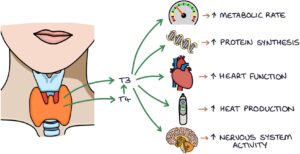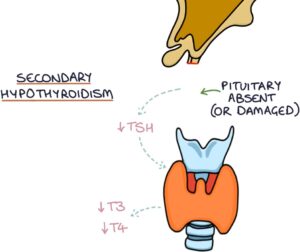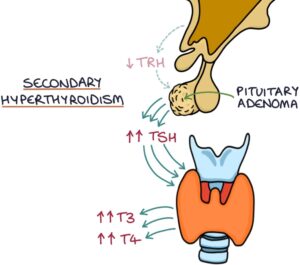The thyroid gland sits at the front of the neck and produces the two thyroid hormones:
- Triiodothyronine (T3)
- Thyroxine (T4)
T4 breaks down into T3 in the tissues. T3 is the more active thyroid hormone. T4 has a longer half-life of around seven days compared with the half-life of T3, which is around one day. The longer half-life of T4 helps to keep thyroid hormone levels more stable over time.
Thyroid Hormone Production
Inside the thyroid gland there are structures called follicles. These structures are lined by follicular cells and contain a fluid called colloid. The follicular cells produce thyroid hormones.
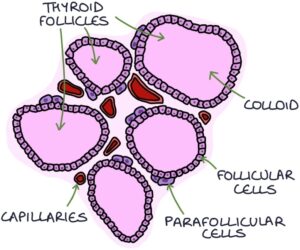
Iodine is essential in the production of thyroid hormones. Iodine enters the follicular cells and colloid as iodide (I–). Thyroid peroxidase is an essential enzyme in the colloid that oxidises iodide (I–) to iodine (I+).
The colloid contains an important protein called thyroglobulin. Thyroglobulin, produced by the follicular cells, acts as a scaffolding structure for the production of thyroid hormones.
CLINICAL RELEVANCE
Iodine deficiency can lead to hypothyroidism (underactive thyroid) and a goitre (swelling of the thyroid).
Antibodies that target thyroglobulin or thyroid peroxidase can be found in autoimmune thyroid diseases, such as Hashimoto’s thyroiditis and Graves’ disease. Antibodies target a specific antigen and tell the immune system to attack that target. Autoantibodies target the body’s own tissues.
Thyroid Hormone Function
The main effects of the thyroid hormones are to:
- Increase the metabolic rate (increasing energy production and expenditure in the body)
- Increase protein synthesis, stimulating growth and repair of tissues
- Stimulate heart function (heart rate and cardiac output)
- Promote heat production in the body, helping maintain the body temperature
- Enhance nervous system activity and mood
Thyroid Hormone Control
Thyroid hormone levels are controlled by two structures in the brain called the hypothalamus and the pituitary gland, specifically the anterior part of the pituitary.
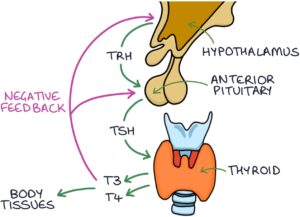
The hypothalamus releases thyrotropin-releasing hormone (TRH). TRH stimulates the anterior pituitary to release thyroid-stimulating hormone (TSH). TSH stimulates the thyroid gland to release triiodothyronine (T3) and thyroxine (T4), the thyroid hormones.
T3 and T4 go off to the body tissues to carry out their effects. They also travel to the brain and have a suppressing effect on the hypothalamus and the pituitary. This is called negative feedback. The presence of T3 and T4 suppresses the release of TRH and TSH. This helps keep the thyroid hormone level within normal limits and relatively stable over time.
When the levels of T3 and T4 get a bit too high, they suppress TRH and TSH, and the lower TRH and TSH result in less thyroid stimulation and less T3 and T4, bringing the T3 and T4 levels back down.
When the levels of T3 and T4 get a bit too low, there is less suppression of TRH and TSH, resulting in more secretion of TRH and TSH, more thyroid stimulation and more secretion of T3 and T4, bringing the levels back up.
TSH, T3, and T4 can be tested on a blood sample to determine whether thyroid function is healthy.
Hypothyroidism
Hypothyroidism refers to when there is not enough of the thyroid hormone, T3 and T4. Inadequate thyroid hormone causes symptoms of:
- Weight gain
- Fatigue
- Dry skin
- Coarse hair
- Hair loss
- Fluid retention (including oedema, pleural effusions and ascites)
- Heavy or irregular periods
- Constipation
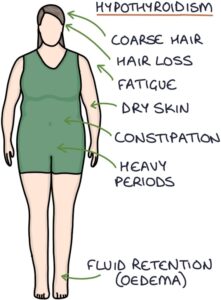
Primary hypothyroidism is where the thyroid behaves abnormally and produces inadequate thyroid hormones. Low levels of T3 and T4 mean a lack of negative feedback to the hypothalamus and pituitary. TRH and TSH are not being suppressed, resulting in increased secretion of TRH and TSH. On a blood test, T3 and T4 are low, and TSH is high. The top causes of primary hypothyroidism are:
- Hashimoto’s thyroiditis
- Iodine deficiency
- Treatments for hyperthyroidism
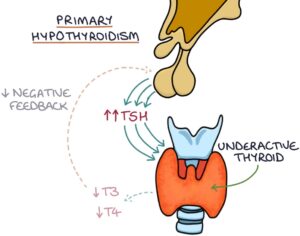
Secondary hypothyroidism is where the pituitary behaves abnormally and produces inadequate TSH (e.g., after surgical removal of the pituitary), resulting in under-stimulation of the thyroid gland and insufficient thyroid hormones. TSH, T3 and T4 will all be low.
Hyperthyroidism
Hyperthyroidism refers to when there is excessive thyroid hormone. Hyperthyroidism causes symptoms of:
- Anxiety and irritability
- Heat intolerance
- Sweating
- Tachycardia
- Weight loss
- Fatigue
- Insomnia
- Frequent loose stools
- Sexual dysfunction
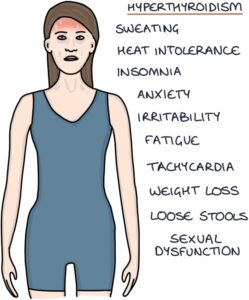
Primary hyperthyroidism is where the thyroid behaves abnormally and produces excessive thyroid hormones. High levels of T3 and T4 act on the hypothalamus and pituitary glands to suppress TRH and TSH. On a blood test, T3 and T3 are high, and TSH is low. The top causes of primary hyperthyroidism can be remembered with the “GIST” mnemonic:
- G – Graves’ disease
- I – Inflammation (thyroiditis)
- S – Solitary toxic thyroid nodule
- T – Toxic multinodular goitre
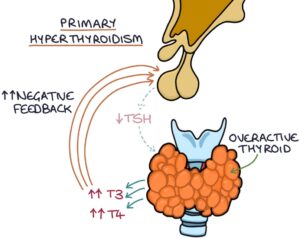
Secondary hyperthyroidism is where the pituitary behaves abnormally and produces excessive TSH (e.g., pituitary adenoma), stimulating the thyroid gland to produce excessive thyroid hormones. TSH, T3 and T4 are all high.
Blood Test Results
|
T3 and T4 |
TSH |
|
| Primary Hypothyroidism |
Low |
High |
| Secondary Hypothyroidism |
Low |
Low |
| Primary Hyperthyroidism |
High |
Low |
| Secondary Hyperthyroidism |
High |
High |
Medications
Levothyroxine is a synthetic version of thyroxine (T4) and is used to replace the missing thyroid hormones in hypothyroidism (underactive thyroid).
Carbimazole inhibits the production of thyroid hormones in the thyroid gland. It is the first-line treatment for hyperthyroidism (overactive thyroid).
Last updated July 2024
Now, head over to members.zerotofinals.com and test your knowledge of this content. Testing yourself helps identify what you missed and strengthens your understanding and retention.

